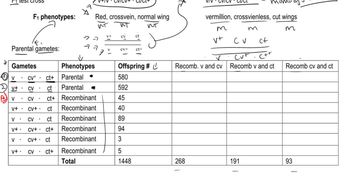4. Genetic Mapping and Linkage
Trihybrid Cross
Practice this topic
- Multiple Choice
The following table shows data from a cross (ABC x abc) examining three genes (a, b, and c). Calculate the recombination frequency for A and B
1034views6rank2comments - Multiple Choice
The following table shows data from a cross examining three genes (a, b, and c). Calculate the recombination frequency for A and C
961views4rank1comments - Multiple Choice
The following table shows data from a cross examining three genes (a, b, and c). Determine the order of genes
643views1rank2comments - Textbook Question
Determine whether the statements below are true or false. If a statement is false, provide the correct information or revise the statement to make it correct.
The outcome of a trihybrid cross is predicted by the law of segregation.
493views - Textbook Question
Determine whether the statements below are true or false. If a statement is false, provide the correct information or revise the statement to make it correct.
The progeny of a trihybrid cross are expected to have one of 27 different genotypes.
425views - Textbook Question
Three gene pairs located on separate autosomes determine flower color and shape as well as plant height. The first pair exhibits incomplete dominance, where the color can be red, pink (the heterozygote), or white. The second pair leads to personate (dominant) or peloric (recessive) flower shape, while the third gene pair produces either the dominant tall trait or the recessive dwarf trait. Homozygous plants that are red, personate, and tall are crossed to those that are white, peloric, and dwarf. Determine the F₁ genotype(s) and phenotype(s). If the F₁ plants are interbred, what proportion of the offspring will exhibit the same phenotype as the F₁ plants?
779views - Textbook Question
Researchers cross a corn plant that is pure-breeding for the dominant traits colored aleurone (C1), full kernel (Sh), and waxy endosperm (Wx) to a pure-breeding plant with the recessive traits colorless aleurone (c1), shrunken kernel (sh), and starchy (wx). The resulting F₁ plants were crossed to pure-breeding colorless, shrunken, starchy plants. Counting the kernels from about 30 ears of corn yields the following data.
What is the interference value for this data set?
471views - Multiple ChoiceSuppose a geneticist is using a three-point testcross to determine the order of three linked genes on a chromosome. Which of the following outcomes would provide the most information about gene order?13views

